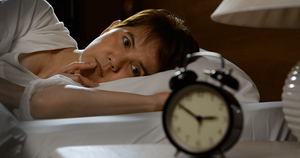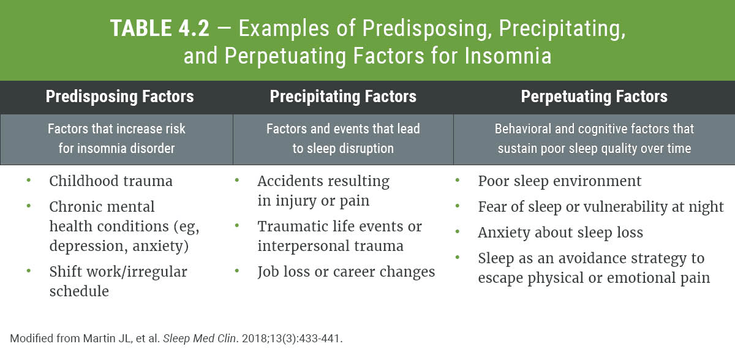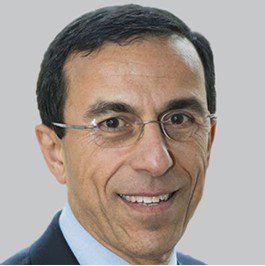Pathophysiology of Insomnia
Introduction
The pathophysiology of insomnia is poorly understood. A variety of hypotheses have been proposed; these include neurophysiologic hyperactivation, psychologic responses directed toward sleep that perpetuate arousal, environmental/genetic influences and neuroendocrine dysregulation of hormones associated with wakefulness. Each of these models is based on clinical and research observations and reflects the complexity of factors that may be responsible for the single complaint of insomnia. The relative contribution of these factors may vary, depending on the severity of the insomnia and the individual (Figure 4-1).

Neurophysiologic Models
Hyperarousal
Studies in insomnia have shown evidence of an overly active arousal system, both during sleep and during waking hours. Manifestations of hyperarousal include…
To continue reading
Log in or register to continue reading. It's free!
OR
By signing up to create an account, I accept Healio's Terms of Use and Privacy Policy.
Introduction
The pathophysiology of insomnia is poorly understood. A variety of hypotheses have been proposed; these include neurophysiologic hyperactivation, psychologic responses directed toward sleep that perpetuate arousal, environmental/genetic influences and neuroendocrine dysregulation of hormones associated with wakefulness. Each of these models is based on clinical and research observations and reflects the complexity of factors that may be responsible for the single complaint of insomnia. The relative contribution of these factors may vary, depending on the severity of the insomnia and the individual (Figure 4-1).

Neurophysiologic Models
Hyperarousal
Studies in insomnia have shown evidence of an overly active arousal system, both during sleep and during waking hours. Manifestations of hyperarousal include elevations in core body temperature, heart rate, catecholamine levels, reactivity to stress and other physiologic changes (Table 4-1). Multiple sleep latency testing (MSLT), which is extensively utilized for the evaluation of the extent of daytime sleepiness, reveals enhanced daytime alertness or a decreased ability to fall asleep during daytime nap opportunities in patients with insomnia compared with normal sleepers (Figure 4-2). In this test, individuals are given five opportunities to fall asleep during the day in a controlled sleep laboratory environment; the speed of falling asleep, i.e., sleep latency, is inversely proportional to the level of sleepiness. Individuals who fall asleep rapidly during these nap tests are, therefore, considered to be highly sleepy. According to current standards, a sleep latency of <8 minutes is abnormal. In this test, even when they were successful in napping, patients with insomnia typically awaken feeling unrefreshed. Paradoxically, therefore, although less sleep (as in sleep deprivation, for example) is typically associated with decreased daytime alertness in otherwise normal individuals, in the reduced nocturnal sleep of insomnia, studies have observed an increased level of activation and arousal.
Hyperarousal has also been described in the following areas in patients with insomnia compared with healthy control subjects:
- Sleep electroencephalography: Patients with insomnia demonstrate faster EEG frequencies than people without insomnia, during both sleep and wakefulness. Faster EEG frequencies represent higher levels of CNS arousal. Specifically, they have reduced low-frequency delta power (typical of deep non-REM sleep) across the night, particularly in the first part of the night and increased high frequency beta power across the entire night. Beta/gamma (very high frequency) activity occurs maximally during shallow stages of sleep and maximally in subjects with insomnia.
- Neuroendocrine axis: Increased cortisol and adrenocorticotropic hormone (ACTH) levels before and during sleep, particularly during the first half of sleep. Higher cortisol concentrations at the time of sleep onset indicate dysregulation of the hypothalamo-pituitary-adrenal (HPA) axis (Figure 4-3). Longer MSLT sleep latencies in people with insomnia are also associated with higher levels of norepinephrine.
- Metabolic brain activity: People with insomnia have increased brain metabolism during non-REM sleep (Figure 4-4). Single-photon emission computed tomography (SPECT) and positron emission tomography (PET) scans reveal increased global glucose metabolic rates during both wakefulness and sleep. The usual sleep-related decline in metabolic rates in brain stem arousal centers is attenuated.
- Physiological and metabolic systems: increase in heart rate, decrease in heart beat-to-beat variability, increase in whole-body metabolic rate during sleep and increase in core body temperature (Figure 4-5).




Circadian Rhythms
Some neurophysiologic models implicate the circadian system in the development of insomnia (Figure 4-6). Circadian rhythm disorders, such as delayed sleep phase syndrome and advanced sleep phase syndrome, are associated with difficulty falling asleep and early awakening, respectively. In these disorders, the circadian system is disturbed, causing an imbalance of sleep/wakefulness, melatonin, cortisol and presumably other endogenous hormones in relation to the environmental light/dark cycle. A genetic basis for these disorders was discovered when a mutation in a human clock gene (PER2) was shown to produce advanced sleep phase syndrome in some individuals. A functional polymorphism in PER3 is associated with delayed sleep phase syndrome and further supports the role of genetics in insomnia.

Genetic and Environmental Models
Patients with insomnia have an increased sensitivity to environmental challenges known to disrupt sleep, such as caffeine, life stressors and changes in circadian phase, requiring less activation to achieve high levels of arousal and disturbed sleep. This sensitivity, known as sleep reactivity, is partially genetically determined and partially related to the extent of the stressor.
Heightened cognitive and physiologic hyperarousal, evidenced by high heart rates and sympathetic activation, are characteristics of individuals with high sleep reactivity to environmental stressors. Patients with difficulty sleeping under stress have been shown to have significantly lower sleep efficiencies (ratio of total sleep time over time spent in bed) and longer sleep latencies (time to sleep onset) than those without sleep issues. Longer MSLT sleep latencies in patients with insomnia show that sleep reactivity lasts beyond the sleep period.
Although the genetic determinants of sleep reactivity have yet to be identified, it is known that genetic determinants underlie a wide inter-individual variability in a variety of sleep parameters in otherwise normal individuals. These include sleep stage organization, sleep timing, sleep quality and sleep-wake regulation. Circadian genes, neurotransmitters and their receptors, cytokines/immune or stress-response genes, synaptic transmission genes, ion channels and signal metabolic/cellular growth genes have been identified to be important in sleep regulation.
Twin studies in insomnia-related phenotypes have also demonstrated evidence of genetic contributions to insomnia, with additive effects. Twin studies thus indicate that insomnia is moderately heritable, with approximately one third of the variance in symptoms attributable to genetic factors. Another study noted that the correlation between insomnia was greater with monozygotic than dizygotic twins (0.47 vs 0.15). These results have been supported by family studies. Other studies have found similar genetic mutations and genotypes in a rare form of insomnia, fatal familial insomnia. A genome-wide analysis of data from the UK Biobank identified 57 loci associated with self-reported insomnia symptoms. These loci contain more than 200 genes, many of which are involved in ubiquitin-mediated proteolysis and expressed in several brain regions; five genes (DVL1, LRP1, NR1H3, PRKAR2A and SEMA3F) have been implicated in sleep regulation in non-human models. Finally, as noted above, several studies suggest that the genes that regulate circadian rhythms may have some bearing on insomnia phenotypes.
Several epigenetic mechanisms have also been implicated in the regulation of sleep, directing gene-environment interactions in response to stress. An epigenetic programming of the stress response including HPA axis activation and glucocorticoid regulation has been proposed. Thus, the early environment can contribute substantially to the development of stable individual differences in HPA response to environmental stimuli, which may affect behavioral and neuroendocrine response to stressors. Epigenetic modifications explain how environmental factors may cause persistent changes in the brain, leading to behavioral adaptations, thus connecting genetic makeup to manifestations of disease.
Psychological Models
Psychoanalytic Models
Although a variety of psychoanalytic models have been proposed throughout the past century, one widely recognized model is that of Sigmund Freud. According to Freud, sleep occurs when a combination of daily events (“residue”) and conflictual, anxiety-producing, unconscious wishes are transformed into dreams through a series of mental processes collectively classified as “dream work.” Freud theorized that insomnia represents a failure of dream work, the success of which is necessary for the preservation of sleep. The failure of dream work is due to the intensity of the anxiety caused by the underlying conflict, resulting in the awakening of the dreamer.
Cognitive and Behavioral Constructs
Cognitive and behavioral constructs rely on the importance of sleep-related thoughts and associated behaviors in the genesis of insomnia (Figure 4-7). Contributing factors to insomnia can also be grouped temporally, into characteristics that predispose an individual to insomnia (such as genetic factors), events that precipitate the acute sleep disorder (such as environmental influences) and attitudes and practices that perpetuate the problem, transforming it into a chronic condition (Figure 4-1 and Table 4-2).
Cognitive and emotional arousal due to traumatic events and stressors can precipitate insomnia in most individuals. However, genetic predisposition, as noted above, results in an exaggerated reaction in people with insomnia. In addition to genetic predisposition, patients with insomnia report difficulty relaxing, feeling tense and anxious, being overly preoccupied with a myriad of thoughts, being worried and being depressed more frequently than control subjects. Other predisposing factors, such as distorted beliefs about sleep itself, including the belief that poor sleep is inevitable, that the lack of a full night of sleep will inevitably lead to disastrous health consequences and that a minimum of 8 hours of sleep per day is critical to maintain health, can induce further emotional and cognitive arousal.
Such catastrophizing is encouraged by many nights of poor sleep, which can foment cognitive rumination and worry about not falling asleep and about the potential for disastrous next-day consequences of sleeplessness. Therefore, such a cycle of apprehension and worry can perpetuate insomnia and make future sleep even less likely. Finally, patients with insomnia are prone to excessive cognitive monitoring at bedtime, which can further perpetuate insomnia; they carefully monitor mental and body sensations, as well as external cues such as the bedroom clock and environmental noises.
Insomnia can also be triggered or maintained by maladaptive behavioral practices that lead to insufficient sleep drive, attenuated circadian sleep propensity, or an increased arousal level at bedtime (Table 4-3). In order to diminish sleep difficulties, patients with insomnia tend to develop maladaptive behaviors, such as increasing the time spent in bed, going to bed earlier and increased awareness of mental and body sensations. These strategies are not efficient since they contribute to the elevation of somatic, cognitive and cortical activations. Arousal at bedtime may be a learned response, in which the repeated experience of poor sleep transforms bedtime rituals and environment into contextual cues for arousal rather than for sleep. Other psychological factors, such as perfectionism, the need for control, excessive worrying and depression, also have been found to be associated with insomnia.
In summary, although the pathophysiology of insomnia has yet to be clarified, data are pointing to a heightened responsiveness to stressful experience in affected patients, leading to hyperarousal during sleep and wakefulness. This vulnerability may, in turn, be genetically mediated. Once insomnia arises, it can, in turn, be fomented and perpetuated by a variety of maladaptive cognitive and behavioral factors. These theoretical formulations, in turn, suggest that a multidimensional approach may be best suited for the management of insomnia.


References
- Doghramji K, Doghramji PP. Clinical Management of Insomnia, 3rd ed. Professional Communications Inc. 2023.
- Bonnet MH, Arand DL. Heart rate variability in insomniacs and matched normal sleepers. Psychosom Med. 1998;60:610-615.






